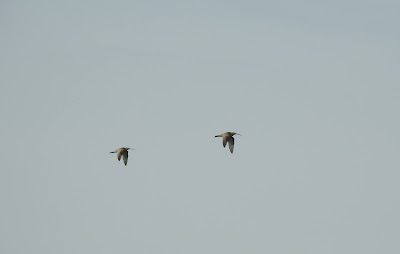Before I get in to the topic of this post, I want to apologise for the
quality of the
Curlew pictures. These birds were busy alarm calling, and
flying round me, giving me grief, which is exactly what they should be doing,
and was an excellent sign, as it meant that they had young; good news indeed!
Curlews
I was back in Bowland on my conservation mad client's farm, and for the
first time in years I was walking the lower, more intensive section of the farm
below the road. I spend lots of time on the top half of the farm, above the
road, where the majority of the conservation management goes on, where the aim
is to provide optimum habitat for breeding waders.
Curlew
Most of the meadows on the farm are on this more intensive (and this is in
relative terms) lower part of the farm, and as such this is where a number of
the Curlews nest. It was a pleasant morning, and I had nearly full cloud cover
with a light southerly wind when I set off on my walk.
Curlew
I recorded at least 5 - 6 pairs of Curlew, which was the objective for my
visit, and they were either still on eggs, or had young, based on their actions
e.g. alarm calling and agitated behaviour (chicks) or quietly slipping away
through the sward of the meadow (on eggs). I wanted to look at the distribution
of the Curlews on this section of the farm, see how many pairs there were, and
start looking at ways of improving the habitat for them.
Of course, as I was wandering along looking at and thinking about Curlews, I
did jot other bits and pieces down in my notebook. The farm is good for
Brown
Hares, and I recorded eight animals during my walk.
Brown Hare
A number of birds were singing from various bits of hedgerow and scrub
including two
Blackcaps, eight
Willow Warblers, two
Song
Thrushes and a
Garden Warbler. There's certainly more Garden
Warblers around this spring, so let's hope they have a good breeding season.
An area of species-rich grassland on a small hillock held at least 20 - 30
Chimney
Sweeper Moths, and I realised why, when I noticed abundant Pignut
throughout the sward in this area. Pignut is the food plant of the Chimney
Sweeper Moth caterpillars.
I had two
Great Spotted Woodpeckers, and also the only raptor species
I recorded,
Buzzard, numbered two. My best bird, except for the Curlew
of course, was a singing
Cuckoo, but it was distant alas, and I didn't
have any chance of seeing it. Nice to record though!
I finished off with 80 moulting
Mallards on one of the numerous
wetlands on the farm, and in with them was a single male
Tufted Duck.
Moulting Mallards
The forecast is looking okay at the moment for some ringing on Sunday in the
Obs reedbed, so if I get there, I'll let you know how I get on.





No comments:
Post a Comment